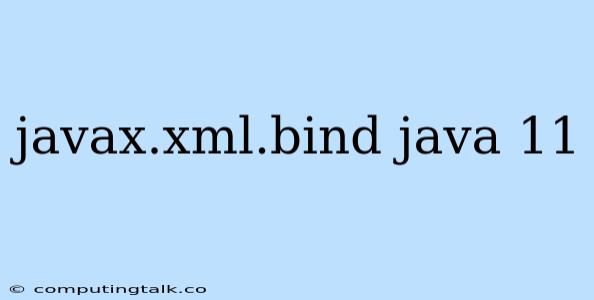The javax.xml.bind package, which provides support for JAXB (Java Architecture for XML Binding), was removed in Java 11. This removal was part of a broader effort to modularize the Java platform and reduce the overall footprint of the JDK. While this change might seem drastic, it's actually a positive step towards a more streamlined and efficient Java environment.
Why was javax.xml.bind removed?
The main reason for the removal of javax.xml.bind is its dependency on the Java EE platform. This dependency created a significant burden on the JDK, making it larger and more complex. By removing the package, Java developers are encouraged to adopt more modern and modular alternatives for XML processing.
What are the alternatives?
Here are some popular alternatives to javax.xml.bind:
- Jackson: Jackson is a high-performance JSON processor that can also be used for XML parsing. It offers a flexible and efficient way to handle both formats.
- Gson: Gson is another popular library for JSON processing, known for its simplicity and ease of use. It provides seamless integration with Java objects, making it a great choice for various tasks.
- XML Parser: The
javax.xml.parserspackage, still present in Java 11, offers a more basic way to parse XML documents. However, it doesn't provide the same level of convenience as JAXB.
How to Migrate from javax.xml.bind
If your existing Java projects rely on javax.xml.bind, migrating to one of the alternatives mentioned above is essential. Here's a general approach to the migration process:
- Choose an alternative: Select the library that best fits your needs and project requirements. Consider factors such as performance, ease of use, and community support.
- Add the dependency: Include the selected library in your project's dependencies using your build tool (Maven, Gradle, etc.).
- Convert code: Modify your code to use the new library's API. This might involve restructuring your code to work with the new data structures and methods provided by the chosen library.
- Test thoroughly: Test your application thoroughly to ensure that the migration was successful and all functionality remains intact.
Example Migration: From JAXB to Jackson
Let's assume you have a simple Java class that uses JAXB for XML serialization:
import javax.xml.bind.annotation.XmlRootElement;
@XmlRootElement(name = "user")
public class User {
private String name;
private int age;
// Getters and setters
}
To migrate this code to Jackson, you can modify it as follows:
import com.fasterxml.jackson.annotation.JsonProperty;
import com.fasterxml.jackson.dataformat.xml.annotation.JacksonXmlRootElement;
@JacksonXmlRootElement(localName = "user")
public class User {
@JsonProperty("name")
private String name;
@JsonProperty("age")
private int age;
// Getters and setters
}
You would then add the Jackson dependency to your project's build file and use Jackson's API for serialization and deserialization.
Conclusion
While the removal of javax.xml.bind in Java 11 might seem like a significant change, it ultimately pushes Java developers towards using more modern and flexible solutions for XML processing. This move aligns with the overall goal of making Java more efficient and modular. By adopting one of the alternatives, you can continue to enjoy the power of Java while embracing a cleaner and more streamlined development environment.
